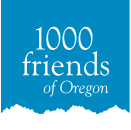By Brett Morgan | 2.5-minute read
About UGB Land Swaps
The land use planning program allows UGB exchanges in rare circumstances whereby jurisdictions respond to unanticipated growth in certain areas. The UGB exchange process brings land outside the existing UGB into the UGB for development and removes the same amount of land inside the existing UGB (this is why we refer to this process as an UGB land swap).
Metro Council unanimously voted this month to address regional housing affordability and availability through its first-ever urban growth boundary (UGB) land exchange. The vote brings approximately 500 acres (dubbed River Terrace 2.0) adjacent to the City of Tigard into the existing UGB for development purposes, and removes approximately 500 acres in Clackamas County from the existing UGB where development is not anticipated.
In testimony ahead of the vote, 1000 Friends of Oregon highlighted the City of Tigard’s efforts to encourage housing production for households of all income levels through policy changes and funding allocation. Essentially, the City of Tigard has taken measurable action to maximize their land inside the existing UGB to allow and encourage housing production.
“Southwest Washington County has experienced immense growth,” said Brett Morgan, Transportation and Metro Policy Manager at 1000 Friends of Oregon. “But it remains unclear if long-term issues around transportation, water-system health, and farming have been addressed.”
Adding land to the UGB doesn’t guarantee housing, and it doesn’t guarantee the desperately needed housing affordable to most Oregonians. Accessible housing isn’t merely affordable; it also requires adequate access to resources, transportation, and healthy environments.
Our community partner Tualatin Riverkeepers also raised additional erosion concerns. “Stormwater does not recognize jurisdictional boundaries, so it is not enough to think within those same limitations. It takes collaboration at all levels to ensure healthy growth that services all Oregonians,” said Victoria Frankeny of Tualatin Riverkeepers. In the vote, Metro Council included an amendment intended to respond to the current erosion problems highlighted by Tualatin Riverkeepers.
What comes next?
1000 Friends and Tualatin Riverkeepers will be helping the region, including the Metro Council, be successful in this first-ever UGB swap. To do so, we must first look to Metro. Metro provides a core service in our region – long-range land use planning and development – that benefits local jurisdictions, home builders, developers, environmental and community organizations, and residents alike. This includes forecasting hazards, developing a public facilities plan, and identifying natural resources and mitigating the consequences of these resources from proposed development.
We will use indicators for success to help all of us not only be mindful of the purpose behind the UGB swap, but focused on achieving the stated outcomes. Our indicators for success include:
- Building of 20 dwelling units per acre, as congruent with the estimates from the River Terrace 2.0 comprehensive plan
- Delivery of an affordable-housing plan with the City of Tigard
- Erosion mitigation measures adopted through the Clean Water Services Plan Update, and as meets the conditions placed by the Metro Council
- Engagement in a transit study plan with the City of Tigard, Washington County designed to deliver accessible and efficient transit options to the River Terrace 2.0 Community and the surrounding community.
As we keep an eye on the developments following the UGB land swap, we’ll keep you up to date on its progress.
